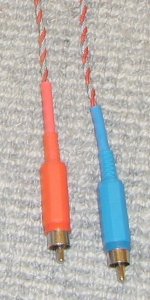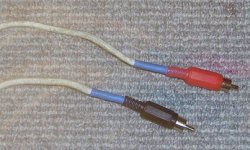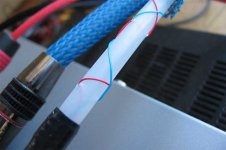jleaman said:This sux every *Am time i see a company with some of my ideas and thoughts it proves me more and more that i should just give up. 🙁
Bah! If you're passionate about what you're doing and you believe in your product, don't give up!
I think i just wasted all this money on silver wire and stuff. 🙁
Why do you say that?
Man, you're almost making me feel guilty. Or is that your evil plan? Guilt trip the competition out of business? 😀
se
Member
Joined 2002
PauSim said:Hey hey hey 😱
Never give up just because you feel like a junior watching the big boys playing ball.
Keep on working, man.
Absolutely!
Not that I'm any sort of "big boy." Not by any stretch.
se
well thats a bit more information than I expected. Ok well I am going to give some of these different idea's a try. The 28 guage wire I used was the thinnest wire I had ever used before, maybe I should try some 30 guage, it was something I was intrested in experimenting with.
Where do you find 30 guage wire with silk insulation, let me guess, its custom or a trade secret or something. I have seen others use silk wound wire and been intrested in trying that possibly.
Where do you find 30 guage wire with silk insulation, let me guess, its custom or a trade secret or something. I have seen others use silk wound wire and been intrested in trying that possibly.
jleaman said:wanna work together ? some what ?
Not quite sure what you mean here, but I'm not one to work against someone just because they can be considered "competition." If I can help you out somehow I'll do what I can.
se
pjpoes said:Where do you find 30 guage wire with silk insulation, let me guess, its custom or a trade secret or something. I have seen others use silk wound wire and been intrested in trying that possibly.
No, no trade secret. But it was made custom for me so it's not something you can get off the shelf. The only trade secret is the alloy that I'm using but if you want to have your own wire served with silk, talk to Hal Marker at HM Wire.
There's no one in the US doing silk these days (at least no one that I'm aware of or Hal's aware of) so the serve is done through one of HM Wire's affiliates over in France, a company called Sofilec.
They have a minimum lot charge of I think $450 or so so it won't exactly be cheap.
se
Member
Joined 2004
pjpoes said:well thats a bit more information than I expected. Ok well I am going to give some of these different idea's a try. The 28 guage wire I used was the thinnest wire I had ever used before, maybe I should try some 30 guage, it was something I was intrested in experimenting with.
Don´t forget to use the same geometry and connectors. Analogue_sa´s words make a lot of sense.
Member
Joined 2004
Oolala! Another good link to add to my favourites.
Steve, since you get your wire from Europe you may also try this manufacturer (in case in didn´t).
http://www.wires.co.uk/acatalog/sitemap.html
Look for silk covered copper.
No special alloys for us DIYers I´m afraid.
Here´s my own attempt at silk insulation, from Dr. Gizmo´s recommendations in Listener magazine. 24 awg solid silver and cheap connectors. The silk came from a crafts shop.
Steve, since you get your wire from Europe you may also try this manufacturer (in case in didn´t).
http://www.wires.co.uk/acatalog/sitemap.html
Look for silk covered copper.
No special alloys for us DIYers I´m afraid.
Here´s my own attempt at silk insulation, from Dr. Gizmo´s recommendations in Listener magazine. 24 awg solid silver and cheap connectors. The silk came from a crafts shop.
Attachments
PauSim said:Steve, since you get your wire from Europe you may also try this manufacturer (in case in didn´t).
Actually I get the wire here. It's then sent over to France to have the silk serve applied and then sent back here.
Thanks. Yes, I'd been to that site before. Lots of interesting stuff there and in fact I'd tried some of it before I eventually settled on what I'm using now.
No special alloys for us DIYers I´m afraid.
Well they do have some silk insulated Constantan which is a 60/40 copper/nickel alloy which sounds very good in my opinion. Though its high resistance limits the length of runs you can use it for unless you parallel a whole bunch of it.
I had Mills Resistor make me some custom wirewounds out of that alloy for use in a headphone amp I made some time ago and they sounded fantastic. I told my friends at Coda Technologies about it and they were interested in it and had some made for the emitter resistors in the higher end amplifiers to replace those they were using that were made using the more common nichrome alloy.
They were rather amazed with the results as well.
Don't let the fact that the alloy has nickel in it scare you. The alloy is actually paramagnetic. Copper/nickel alloys don't start exhibiting ferromagnetic properties until the nickel content gets up to around 80%.
However the silk insulated Constantan wires that wires.co.uk are selling also have an enamel on them so they're not exactly a bare wire insulated with silk.
Here´s my own attempt at silk insulation, from Dr. Gizmo´s recommendations in Listener magazine. 24 awg solid silver and cheap connectors. The silk came from a crafts shop.
Coolness!
So what's going on here? You got some silk braid from a crafts store and slid it over the wire and then twisted them together?
Actually I'm currently working with another French company to produce some custom silk braid for my cables. I've come to find that the "nude" cables really weren't up to being handled by the average audiophile. While I've yet to have a cable fail, I'd got some back that just looked plain ugly. Dirty and all kinked up.
I'm working on a new version of the cable that uses four strands as in the original, but instead of braided they're just a simple, straight parallel quad inside a braided silk jacket.
I found they sound every bit as good as the nudes (in some ways even better) but they have a much better "feel" to them and don't have the rather stiff, springy, kink-prone, mind-of-its-own quality of the nudes.
The jacketing also allows me to wax the silk insulated wires. Something that I had very good results with with the nudes in development but something I opted not to do with the production version becasue while the wax, which was applied dry and the cables warmed up to the wax's melting point which caused it to wick into the silk, gave the cables a nice light brownish color (because it made the silk translucent so the color of the conductors showed through), if you bent the cable too severely or scraped it with a fingernail, it would slightly separate the fibers and the wax making that portion of the cable look white.
Didn't want any blotchy looking cables out there. 🙂
se
thicker wire was louder than the other
Could it be the reason is not resistance? The only application where resistance seems paramount - the wire between a MC cart and a step-up device, ironically insists on the thinnest gauge possible - and without obvious shortcomings.
analog_sa said:
Could it be the reason is not resistance? The only application where resistance seems paramount - the wire between a MC cart and a step-up device, ironically insists on the thinnest gauge possible - and without obvious shortcomings.
You nailed it I think. Resonances and other types of distortion will make a cable sound subjectively louder. Larger diameter is bad to my ears, the 24 ga listeted earlier seems the edge. At that size the sound has started to degrade. 26 - 28 is about right.
George
Howdy, George!
What resonances and other types of distortion are you referring to here?
se
Panelhead said:You nailed it I think. Resonances and other types of distortion will make a cable sound subjectively louder.
What resonances and other types of distortion are you referring to here?
se
Steve Eddy said:Howdy, George!
What resonances and other types of distortion are you referring to here?
se
Electron spin resonances - these are obviously the worst ones 😉
PMA said:Electron spin resonances - these are obviously the worst ones 😉
Oh absolutely. The electrons get so dizzy they get sick and hurl quarks. 😀
se
Member
Joined 2004
Steve Eddy said:
Thanks. Yes, I'd been to that site before. Lots of interesting stuff there and in fact I'd tried some of it before I eventually settled on what I'm using now.
Hi,
I´ve yet to order anything from them.
Did you try the gold-plated silver and the titanum?
Thank you for the advice on the constantan alloy.
So what's going on here? You got some silk braid from a crafts store and slid it over the wire and then twisted them together?
That´s right. Pretty simple, isn´t it?
Please note that English is not my native language and "crafts store" may not be the usual designation.
I was told the silk braided tubing is used for making belts and curtain cords and the stores that sell it also sell shirt buttons and fabrics.
It must be miles away from the silk you get from France.
I´m almost sure the one I got is artificial silk or a mix of natural and artificial materials, as it feels both satin smooth with a disappointing hard edge, like sharp hills on a prairie.
These add a certain sonic signature that I dislike.
A while ago I plugged them between CD player and integrated amp and listened to "Platinum" from Mike Oldfield.
It sounded fast and detailed, possibly due to the air between the braids and the 33 pF per metre capacitance. On track nr. 4, Oldfield´s version of Philip Glass´Northstar, when the speed guitar enters at 3:15, the background choir, drums and bass don´t get compressed. Quite satisfying if it wasn´t for the sharp envelope edges in which the individual instruments are contained. These get really annoying on track nr.1 at 4:00 where it´s all glockespiel and electric guitar. Almost ear-bleeding.
Switching to all cotton and silver (see photo) the razor edges disappear instantly. The sound is darker and not as fast and detailed and the track nr. 4 bit sounded compressed, certainly due to the 100 pF for 80 cms. The cotton sleeves are thinner than the silk braids and I believe I also overtwisted the wires. But this cable sounds quite musical and pleasant.
Actually I'm currently working with another French company to produce some custom silk braid for my cables. I've come to find that the "nude" cables really weren't up to being handled by the average audiophile. While I've yet to have a cable fail, I'd got some back that just looked plain ugly. Dirty and all kinked up.
I'm working on a new version of the cable that uses four strands as in the original, but instead of braided they're just a simple, straight parallel quad inside a braided silk jacket.
I found they sound every bit as good as the nudes (in some ways even better) but they have a much better "feel" to them and don't have the rather stiff, springy, kink-prone, mind-of-its-own quality of the nudes.
I know what you mean. The kinks are the aeternal problem with single strands. A good jacketing protects the cable from dirt, makes it more flexible and good-looking.
I have made some quad cables before. I found them to possess an instantly recognisable character either braided or twisted : "Foot-tapping" is what they´re all about 😉
I´m a big fan of Bossa Nova. Listening to the Getz/Gilberto album through quad cables is an addictive experience. I simply can´t do any other thing besides listen to the music. A quad configuration can bring an extra low octave to the system and the music´s rythmic balance keep grabbing my attention.
The jacketing also allows me to wax the silk insulated wires. Something that I had very good results with with the nudes in development but something I opted not to do with the production version becasue while the wax, which was applied dry and the cables warmed up to the wax's melting point which caused it to wick into the silk, gave the cables a nice light brownish color (because it made the silk translucent so the color of the conductors showed through), if you bent the cable too severely or scraped it with a fingernail, it would slightly separate the fibers and the wax making that portion of the cable look white.
Didn't want any blotchy looking cables out there. 🙂
Certainly not 🙂
Is it real bee´s wax? I purchased some in a drug store. Do you wax the wires before or after twisting? And what´s the value of the dielectric constant?
Member
Joined 2004
Forgot to post the picture: you can see how the wire tangles and the outer cotton jacket (read shoelace ) got dirty with repetitive use. For commercial jacket applications white natural fibers are out. Audio Consulting doesn´t seem to bother about it, but they´ve always showed a hairshirt kind of approach...
Attachments
Member
Joined 2004
analog_sa said:
Could it be the reason is not resistance?
Yes. Because of the thicker wire´s high end rolloff the system may find more room for the rest of the audio range to deal with.
Member
Joined 2002
Member
Joined 2004
Panelhead said:
You nailed it I think. Resonances and other types of distortion will make a cable sound subjectively louder.
Stealth Audio Indra creator Serguei Timachev has a similar approach to it. The following in an edit from his interview to 6moons:
" [...]
There are problems. The largest problem has to do with resonance control. A coaxial cable or one made of two twisted or parallel conductors -- i.e. equidistant over the length of the cable -- has a very pronounced resonance in the RF region. The RF that everyone talks about is well beyond the human hearing range but the intermodulation artifacts -- the subharmonics of two or more closely related RF frequencies as emphasized by this resonance -- do occur right in the audible range. So making a less resonant cable calls for an advanced geometry and more than two simple conductors.
[...]
People don't think about resonances inside an interconnect, but they are very important and one of the main features that can degrade the sound and make it completely unnatural. Sometimes people like what they hear even when what they hear is not natural or accurate. There is nothing any of us can do about that.
[...]
First, you have to be careful. You want to eliminate electrical resonances and optimally dampen mechanical ones. To minimize electical resonance, you need to develop a proper geometry for your cable design. My approach is to have varied, complex relationships among the conductors in a cable that are not in a repetitious pattern to minimize resonances and to have many small ones that are not likely to be sympathetic to one another and which will not amplify. Geometry is very important to proper cable design.
I'm also concerned about mechanical resonance. You can under-damp and you can over-damp. If you under-damp, you get ringing. If you over-
damp, you get lifelessness. You cannot eliminate mechanical resonances completely but you can control them which is why insulation and jacketing material become important. I use a different Teflon than most other designers. It is a Teflon with embedded air bubbles that's much softer and more expensive than the more commonly used variants. It sounds 'fast' because of its ultra-low dielectric constant and I also use it for its resonance control properties.
And this may be an odd comment but all my cables and interconnects are exclusively made by hand. I do this for three or perhaps more reasons. I work with conductors that often can only be worked with by hand. That is certainly true of the amorphous material in the Indra. I also believe that hand-made products cannot help but show the personality of the builder and I like that. Finally -- and this is actually related to resonance control -- there will always be an irregularity of patterns when things are done by hand rather than by machine. And in the case of resonance control, irregular patterns in the geometry are a good thing, I believe. "
Well I find the last paragraph most interesting.
After reading this I feel much more confortable about my lousy braiding techniques 😀
It´s the best reply to LAT International I´ve read. And because it´s the only one so far.
You gotta admire the man´s guts for admitting publically that his stellar priced cables are all hand-braided.
I would think it´s some really clever BS if I didn´t like to see for myself before commenting.
I always waste an extra metre pair of wires each time I have to twist a two metre pair. I use a hand-driller and then cut the 2 metres from the center where the turns are more regular. This way I can achieve a resolution of 3-4 pF per channel.
Manually twisting the wires without feeling any guilt will also allow me to twist the cables in opposite directions. Maybe this increases channel separation. Who knows?
Member
Joined 2002
- Status
- Not open for further replies.
- Home
- General Interest
- Everything Else
- Impressed with new DIY interconnects


